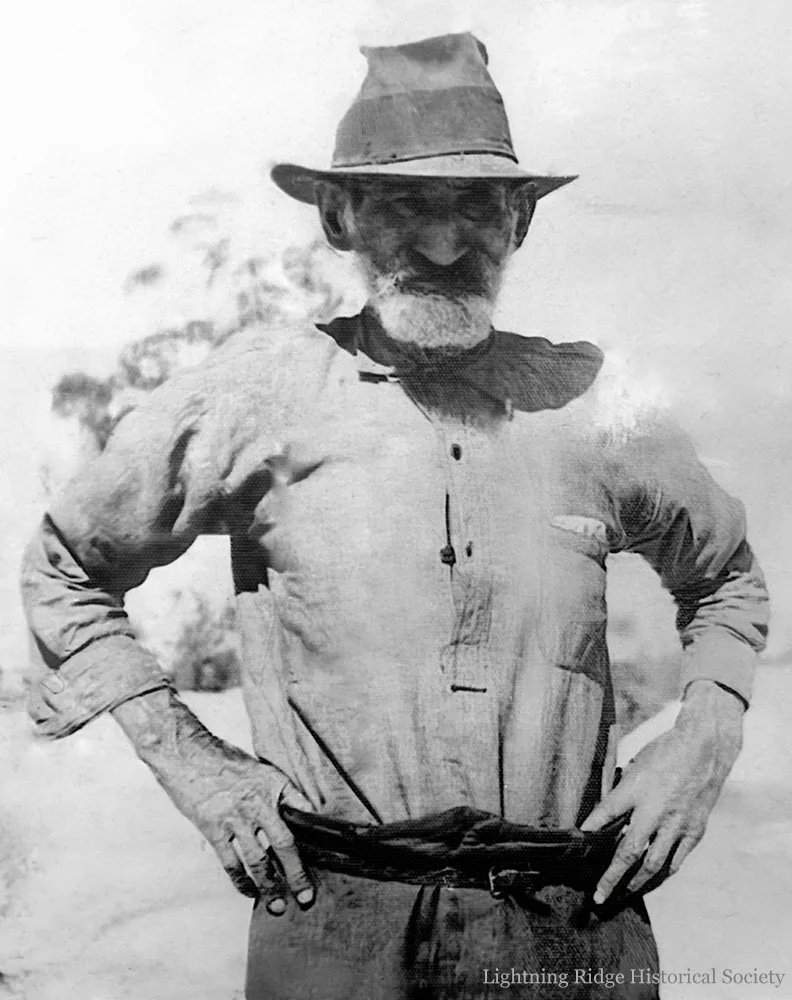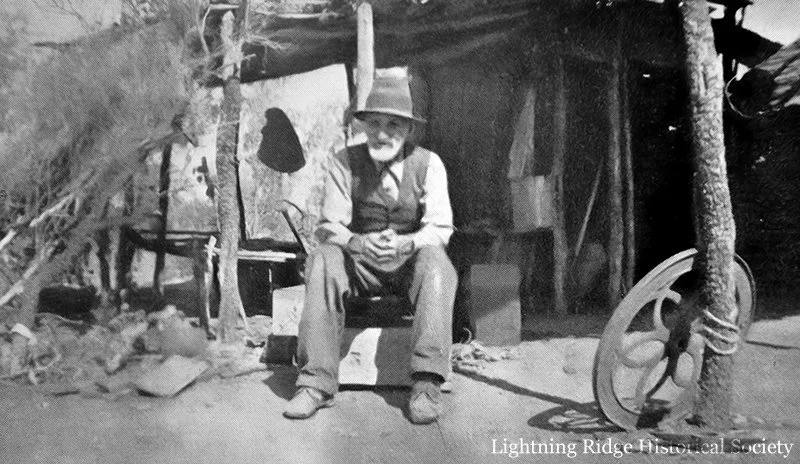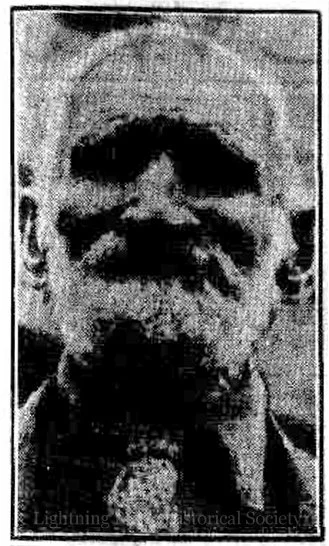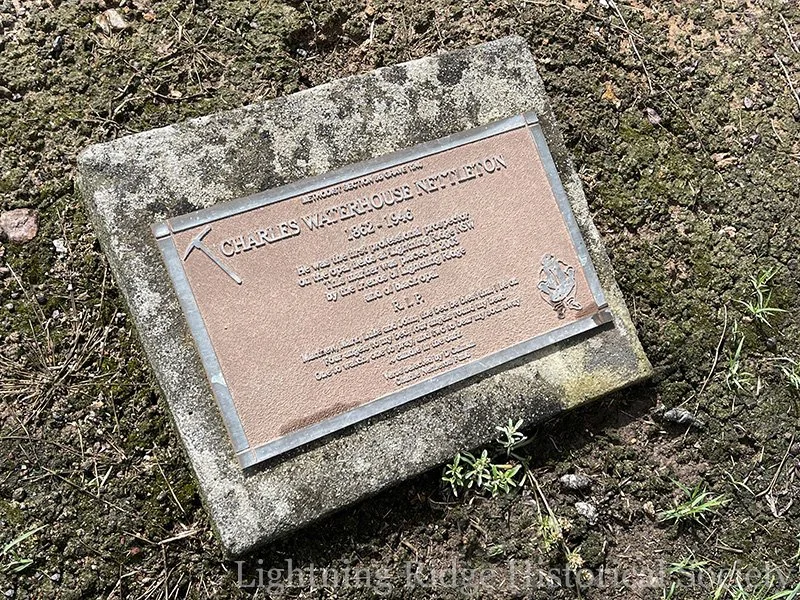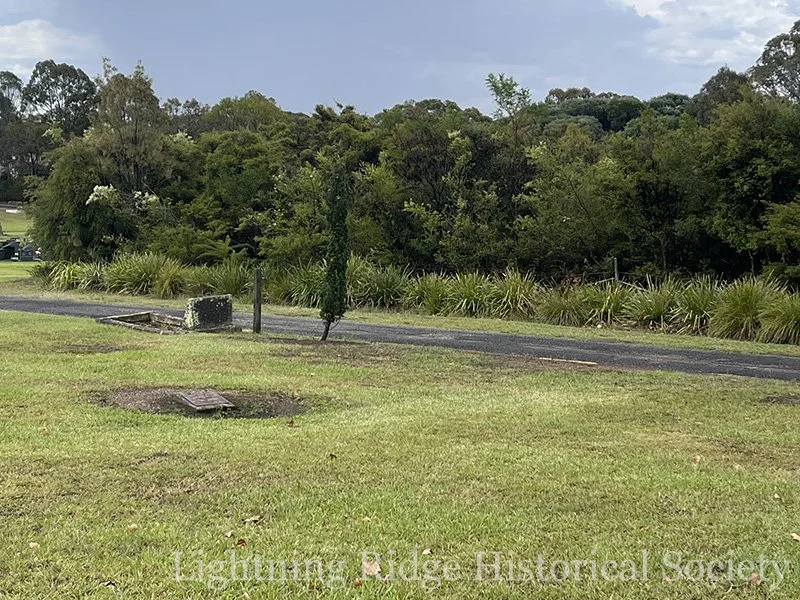Charlie Nettleton
Charlie Nettleton in 1938, Three Mile opal field. Photograph courtesy of Dawn Swane.
Charles Waterhouse Nettleton was one of ten children (fifteen if you include his father's second marriage) of William "Nobby" Frederick Gardner Nettleton (Sobey) and Margaret Emma Davidson. He was born in 1862 at Warrnambool, Victoria.
Charlie was an experienced gold prospector. In the 1880s, he worked on the opal fields at White Cliffs. Prior to 1902, he was on the trail of gold in the Bathurst area, when he was urged by his prospecting partner to head north in search of a rumoured gold reef on Bangate Station, near Angledool.
At Angledool village he chanced to meet Ann Ryan, a boundary rider's wife, who showed him some unusual stones. She found them near their hut at the Lightning Ridge Tank on the travelling stock route. Nettleton recognised the stones as opal, although a strange dark kind, not at all like the light opal he was familiar with from White Cliffs. He knew that “floaters” or surface stones revealed through erosion were an indication of where to mine, so he began sinking shafts on the ridge above the tank.
Nettleton at his camp on Western Fall, 1937.
In 1903, a local mining syndicate was formed with the intention of systematic prospecting. The syndicate was championed by Weetalibah innkeeper Joe Beckett and comprised local station managers, a Sydney geologist and a bookkeeper. They employed Charlie to sink a shaft by hand to 50 feet, however it turned out to be a duffer, producing no precious opal. Very soon after, the syndicate disbanded and Nettleton went his own way.
“Nettleton was a reserved, quiet type of man. He was very thorough when prospecting. If he found a promising location, he would put pegs in and walk up and down searching; moving the pegs about 6 feet each time. He had to find colours before he would sink. Would not sink on evidence of potch only.”
The last known photograph of Charlie Nettleton. Daily Telegraph, 13 December 1940.
Disappointed, Charlie moved across to the Nobby field and worked with Jack Murray. Together they gathered a parcel to take to White Cliffs in the summer of 1903, where it was sold it to E. F. “Ted” Murphy, who later came across from White Cliffs to become a resident opal buyer on the Lightning Ridge fields in 1905.
Charlie mined for opal not only at White Cliffs and Lightning Ridge, he also worked on the Queensland opal fields. He was working in western Queensland from 1913 to 1917, in the Charleville area. He was living at Hackett’s Hotel in Charleville.
The following audio recording features early opal miner Bob Bishop, interviewed in 1961. Bishop worked with Nettleton on the Lightning Ridge and Queensland opal fields, here he talks about Nettleton’s early mining and the walk to White Cliffs to sell the first parcel to E. F. Murphy.
Transcript: “The opal (they) was getting up here, was nobby opal. Charlie got an opal here too, the buyers wouldn't buy it, they wouldn’t. There was no facing nothing at that time. They never faced at all. They used to chop good stones up with a tomahawk. Yeah, selling them for points in colour. Thousands of pounds worth! Well, of course, Charlie got some opal and he took it to White Cliffs. And Murphy, the buyer that came afterwards, didn't understand the opal at all. So he gave Charlie a certain amount on the opal, and that he'd give him the balance when he got his returns from Wollaston. Wollaston, he was buying from them then Wollaston. And then you know, I think Charlie got another dividend out of it. But I think it was just before that, the squatters formed a bit of a syndicate here. Four of them around here. Put in 25 pounds each. Nettleton had a prospect for them and give them the opal. From which he did do, he gave them the opal. Ferris at the old Gerongra station down here, which is now called Bairnkine. He sent the opal away and they told him the opal was of no value, it’s ‘too young’. That's what's come out. So none of those squatters have got anything out of it.”
Reward and acknowledgement
In 1925, Charlie Nettleton was recognised by the New South Wales government with a partial reward for the discovery of the Lightning Ridge opal field. The reward was posted in December of 1896, offering £500 for the discovery of a new mineral field under the stipulations that it must be: a new field, reported to the Minister within a reasonable timeframe, and successful enough to attract at least three hundred miners.
Charlie’s reward was granted only partially because the discovery fulfilled only two of the requirements: it was a new field, and it was successful. Because the application was not submitted until almost 30 years after the reward was posted, a partial reward was granted as an “act of grace, and not a right”. As such, Charles Waterhouse Nettleton remains the only person acknowledged by action of the New South Wales government for the discovery of the opal fields at Lightning Ridge.
‘Reward for the Discovery of New Mineral Fields’, NSW Government Gazette, 31 December 1896, p. 9396; ‘Discovered Opal Field’, Gilgandra Weekly, 22 October 1925, p. 2.
Along with his contribution to the founding of the opal industry at Lightning Ridge, Charlie Nettleton is also credited with the 1928 discovery of the Glengarry opal field to the west of Lightning Ridge.
“Mr. C. W. Netterton (sic), 89, who reached Sydney yesterday from Lightning Ridge. After 39 years tramping the outback prospecting unsuccessfully for gold, he has retired because failing eyesight prevents him nowadays from seeing a “color”.”
Charlie passed away on 12 June 1946 after going blind and relocating to the Salvation Army's Montrose aged care centre (men's home) in Sydney. He is buried in the Methodist section of Rookwood Necropolis in Sydney. For decades, his pauper’s grave lay unmarked. In 2003, the Lightning Ridge Historical Society in association with the Friends of Black Opal placed a marker on Charlie’s grave, funded by Dave Galman. The plaque reads: He was the first professional prospector on the opal fields at Lightning Ridge, NSW.
Charlie Nettleton’s grave marker in the Methodist section of Rookwood Necropolis. Photograph courtesy of Russell Gawthorpe.
A quiet corner: Charlie’s grave with its modest marker. Photograph courtesy of Russell Gawthorpe.
Charlie Nettleton's contributions to Lightning Ridge history are commemorated in the Spirit of Lightning Ridge, a life-size bronze sculpture in Morilla Street. Historically, he is honoured by the naming of the second settlement on the Three Mile Flat, known as Nettleton, as well as Nettleton Drive in the newer residential part of the New Town.
The Nettleton settlement on the Three Mile Flat. Photograph: Lightning Ridge Historical Society.
An enduring legacy of Nettleton’s family history is the word ‘nobby’, which may have arisen from Charlie Nettleton’s father’s nickname. The nobby opal formation is unique to Lightning Ridge, and as per the sales ledgers of E. F. Murphy, in the earliest days these nodular stones were referred to as ‘walnuts’ — at some point, miners and buyers took to calling them ‘nobbies’, perhaps a reference to Nettleton’s heritage.
“Charles Waterhouse Nettleton’s grave was marked in Rookwood Cemetery, Sydney, on July 9th. Thirty friends of Lightning Ridge and black opal attended on the sunny Wednesday morning. Apologies were received from Joy Clayton and Peter Sherman of the opal industry, Shirley Collins, whose father owned the Imperial Hotel 1909-1927 (today’s Diggers Rest), Josephine Bastien and Erica Veveers, daughters of Andy Bastien, Ridge miner 1912-1928, and Sam and Muff Nettleton of Narrabri, who aren’t descendents but would like to be - their grandson is Charlie!
With this meaningful event, 100 years of the black opal industry has been formally commemorated. Nettleton is the man we credit with selling the first parcel of black opal in White Cliffs. He spent 40 years on the Ridge and Grawin fields. At 80 years old and nearly blind, he went into care at the Salvation Army Men’s Home ‘Montrose’ at Balmain in Sydney 1942-1946. He was buried in a pauper’s grave in the Methodist Section at Rookwood on 12 June 1946.”
Charlie Nettleton’s signature sourced from a letter sent from Balmain Men’s Home, 8 December 1944.
Article: Research by Leisa Carney and Russell Gawthorpe, edited by Russell Gawthorpe. LRHS research compiled by Len Cram and Barbara Moritz. Sources: ‘Reward for the Discovery of New Mineral Fields’, NSW Government Gazette, 31 December 1896, p. 9396; Annual Report of the Department of Mines, 1905, NSW Mines Department, p. 68; An Old Chum Remembers: The Story of Lightning Ridge 1906-1921, John M. Landers, 1923, pp. 3-4; J. Drayton, ’Real Opals in the Ring’, Smith’s Weekly, 26 May 1923, p. 29; ‘Discovered Opal Field’, Gilgandra Weekly, 22 October 1925, p. 2; J. M. Landers, ‘Black Opal - Famous Lightning Ridge Gems’, Sydney Morning Herald, 14 July 1928, p. 11; J. M. Landers, ’Court of the Flame Queen’, The Sun, 15 June 1935, p. 8; Death certificate, Charles Waterhouse Nettleton, NSW Births Deaths & Marriages, ref. 1946/017559; They Struck Opal!, E. F. Murphy, 1948, p. 151; The Occurrence of Opal at Lightning Ridge and Grawin with Geological Notes on County Finch, J. W. Whiting & R. E. Relph, 1958, p. 12; The Opal Book, Frank Leechman, 1961, pp. 69-74, 223; The Lightning Ridge Book, Stuart Lloyd, 1967, pp. 11, 61, 85-90, 137-139; ‘Will Our Opal History Be Lost?’, Western Magazine, 4 June 1976, p. 7; Beautiful Lightning Ridge - Home of the World Famous Black Opal, Len Cram, 1991, pp. 2-3; Beautiful Lightning Ridge and History, Len Cram, 1996, pp. 2-6; A Journey with Colour: A History of Lightning Ridge Opal, Len Cram, 2003, pp. 15-16, 18, 69, 265; 346; E. O’Callaghan, Nobby: An Outline of the Life of William Frederick Gardiner Nettleton, 2004, p. 1.

